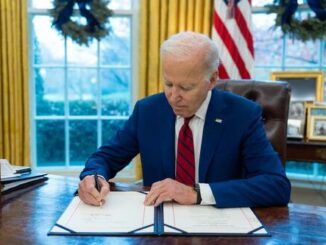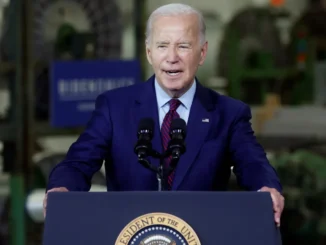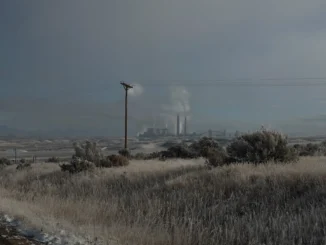
The office running a crucial part of President Joe Biden’s climate agenda has Congress’ approval to lend more than $200 billion for next-generation energy projects — from solar farms and batteries to hydrogen production and lithium mining.
So far, it’s given the go-ahead to a little more than $25 billion. And even as the administration envisions issuing tens of billions more in the next two years, most of the program’s potential will almost certainly remain untapped come Inauguration Day — a reality that may leave its fate in the hands of a President Donald Trump.
The gap between the Energy Department lending power and the money it has approved to date illustrates both the scope of Biden’s climate ambitions and the staggering challenge of achieving them. Early in his term, Biden persuaded Congress to approve roughly $1 trillion in programs to tackle climate change, rebuild U.S. manufacturing, restore the nation’s infrastructure and best China in chips technology. Now his agencies are racing to get the money out the door.
For DOE’s Loan Programs Office, the roughly $25.8 billion in conditional and final loans and loan guarantees it has announced during Biden’s presidency represents a huge burst of activity after the program went largely fallow in the Trump era.
But it has much more left to lend: At the end of March, the office had $217.6 billion in estimated loan authority, thanks to a massive infusion from Biden-era laws such as the Inflation Reduction Act.
The office said it had received 203 active applications, seeking a total of $262.2 billion.
Handing out that cash — without allegations of waste or scandal — is no small task for the DOE, which still faces Republican attacks for its failed Obama-era loan guarantee to the solar manufacturer Solyndra. Though its leaders say the lending decisions will necessarily take time to complete, some Democrats worry about what would happen to the program under Trump, who has railed against what he calls Biden’s “Green New Scam.”
“It would just die on the vine,” Sen. Martin Heinrich (D-N.M.) said in an interview.
Heinrich said the loan program is “one of the most important tools we have to be competitive with an aspirational China. And I worry that if there were a Trump administration, we would give that up.”
Energy Department leaders say they’re aware of the ticking clock — but are also trying to ensure the money goes to projects that meet the goal of transforming the nation’s energy sector.
“We don’t want to leave anything on the table. But I understand that you’ve got to do it right,” Energy Secretary Jennifer Granholm told POLITICO.
“By nature,” she said, the office is “loaning in places that have not been loaned to before.”
Burst of lending
The Energy Department’s loan office was created under President George W. Bush. Democratic administrations have infused it with funds and staffing since then, in hopes of fostering cleaner alternatives to fossil fuels.
In the Obama era, the office had a loan portfolio — estimated at the time at $34 billion — that’s been credited with helping drive a sharp drop in the costs of solar and wind power, as well as boosting a fledgling car company called Tesla.
But a few losses in its portfolio — most infamously, Solyndra’s default on a $535 million loan guarantee in 2011 — created a political glare that slowed the loan operations. Under Trump, whose budgets proposed scrapping the loan guarantees, the office’s enormous base of taxpayer-backed financing went mostly untapped, aside from adding more federal support to a nuclear plant in Georgia.
Then Biden revived the loan office, hiring popular clean-energy entrepreneur Jigar Shah to run it. Its mission, Shah has said, is to provide a “bridge to bankability” for projects that will help eliminate U.S. greenhouse gas pollution but may have trouble getting financing from commercial banks.
Congress, meanwhile, provided the office with new money and programs through statutes such as the IRA, Biden’s 2022 climate law. That legislation, for example, appropriated about $11.7 billion to support issuing new loans — increasing the office’s loan authority by approximately $100 billion.
Activity since then has been steady, but not as fast as some supporters would like.
The office has issued final approval for $6.1 billion in active Biden-era loans and loan guarantees to four companies — backing residential solar installations, hydrogen, mineral production and electric vehicle battery manufacturing. It has extended more than $19.7 billion in conditional commitments to more than a dozen other companies — many of which observers expect will close in the months ahead.
The administration’s most recent budget request envisions these numbers continuing to climb. It anticipates obligating an estimated $27.1 billion in loans and loan authority during the current fiscal year, and as much as $48.7 billion in fiscal 2025.
Some of the money could go to nontraditional recipients: Last month, the office backed its first-ever project on tribal lands, conditionally committing a $72.8 million loan guarantee for a solar and battery project on the lands of the Viejas Band of Kumeyaay Indians near Alpine, California.
It followed that with a $2.26 billion conditional commitment to help finance a lithium processing facility in Nevada. Projects to construct hydrogen production facilities and to finance a transmission line to carry electricity from Wyoming are working their way through the loan process.
“We’ve made a lot of good progress to date and are optimistic we can close many of those conditionally committed loans soon,” Shah said during a recent conference.
The office estimates that it has seen losses representing roughly 3 percent of its portfolio, which is competitive with private-sector entities that service more traditional, less-risky loans. But concerns about DOE’s caution and a potential Trump victory are creating another level of anxiety for some program advocates.
“People are frustrated with the pace,” William Pizer, the incoming president of the energy-focused nonpartisan group Resources for the Future, said during an interview last month at an industry conference in Houston. On the other hand, he said, clean energy supporters would “also be frustrated if all the money went out the door and it didn’t do anything.”
‘A sense of trauma’
Adding to the loan office’s challenges is heavy scrutiny from congressional Republicans, who are watching for any sign of taxpayer money flowing to companies with ethical conflicts, dubious business models or ties to China.
The Energy Department’s inspector general has also warned against spending IRA money too quickly, telling lawmakers last year that “all of these things happening at once create[s] a level of risk that may candidly be described as unprecedented.” The IG, Teri Donaldson, also said she was “greatly concerned” about funding U.S. adversaries like China — a risk that lawmakers of both parties have expressed concerns about.
In addition, DOE added extra layers of scrutiny to the sometimes years-long loan approval process after the Solyndra furor. The fear of political blowback from potential loan defaults could also be constraining the office’s lending, according to some industry people who follow the program’s activities.
“There is still a sense of trauma in [the] post-Solyndra environment,” said Jason Grumet, CEO of the trade group American Clean Power Association. “The incentives for doing right are actually not always as strong as the disincentives.”
The program’s supporters attributed the modest progress so far to the office’s need to conduct due diligence — and to rebuild and staff up from the Trump years.
“I think there’s sort of a lag. You can’t go from standstill to sprint just immediately,” said Brendan Bell, who was director of strategic initiatives at the loan office under Obama. “The projects take time. The borrower takes time. All the work that we want the agency to do in terms of doing its diligence underwriting these loans, that’s what takes time.”
Heinrich, who sits on the Senate Energy and Natural Resources Committee, said the office has only now “built the muscle” to be able to produce “a drumbeat” of announcements.
Republican scrutiny tightens
With polls suggesting a coin-flip election between Biden and Trump, some conservatives are amplifying their calls to halt the lending.
“I would love to see a return to free-market energy policy,” said Travis Fisher, director of energy and environmental policy studies at the Cato Institute, who was a senior adviser at the loan office under Trump. “I don’t consider LPO to be nearly as grave a threat to the well-functioning of energy markets as, say, the $3 trillion in production tax credits in the Inflation Reduction Act, but I would welcome a reconsideration of government’s place in the energy landscape.”
Wood Mackenzie, a top energy consultancy, projected last year that IRA credits could reach nearly $3 trillion if extended in future decades.
Trump’s campaign did not respond to requests for comments about whether the former president would try to kill the loan program, as he proposed in his first term. But the campaign has pledged he would “immediately stop all Joe Biden policies that distort energy markets.”
Republicans on Capitol Hill, meanwhile, have criticized some of the loan office’s lending decisions, including a $3 billion partial loan guarantee meant to help a company called Sunnova offer solar power and battery storage to disadvantaged communities.
Among other complaints, top Senate energy committee Republican John Barrasso of Wyoming alleged a potential conflict of interest between Shah and Sunnova, noting that a company board member sat on the board of an industry roundtable that Shah had founded. Republican House members have threatened to subpoena the office for documents on those and other issues.
Shah has repeatedly called the office’s application process “rigorous” and says staff make the final decision on whether an applicant receives a loan. He also consulted with ethics advisers before he started his role at the department and has followed their advice, the department has said.
The loan office is subject to various forms of oversight, including from lawmakers and agencies such as the Office of Management and Budget, Shah said last week during a conference in Philadelphia.
“Even if I wanted to rush a loan through the Loan Programs Office, it’s actually not possible,” Shah said, adding there are “a lot of things I have to do to get full sign-off” on a loan. “I don’t think anyone is really accusing us, except rhetorically, of pushing money out the door quickly. It’s not really possible for us to do that.”
More broadly, the Heritage Foundation conservative policy manifesto Project 2025 urges the next Republican president to “sunset DOE’s loan authority through Congress and eventually eliminate the Loan Programs Office.” The author of the report’s DOE chapter was Bernard McNamee, a commissioner at the Federal Energy Regulatory Commission under Trump.
These threats could pose a “huge risk” for project developers thinking of seeking loans or loan guarantees from the office — particularly given the lengthy vetting process, said Bell, now the chief operating officer at Aligned Climate Capital.
“These infrastructure developers need to know that three to four years from now, when they’re ready to accept a loan, that the Loan Programs Office will be in business,” he said.
Part of the challenge around the election, Shah said Thursday, is whether “the signals that are being sent” to Wall Street, investors and community groups are going to stay the same or “whether those rules are going to be changed and then the way the investments occur end up changing as well.”
The GOP attacks on specific loan recipients could also deter companies from applying, said one Democratic aide who was granted anonymity to discuss the congressional oversight.
“There’s a real witch hunt in effect that has been announced by the Republicans to organizations or companies that want to apply,” the aide said. The message to potential applicants, the person said, is: “You will not only undergo a traditional rigorous financial diligence, but you will undergo this political diligence, which may be very unfair.”



